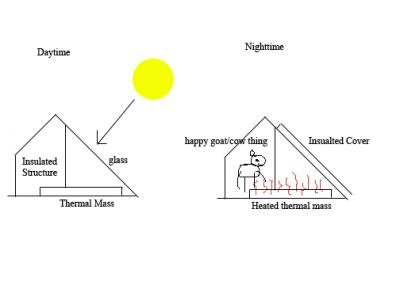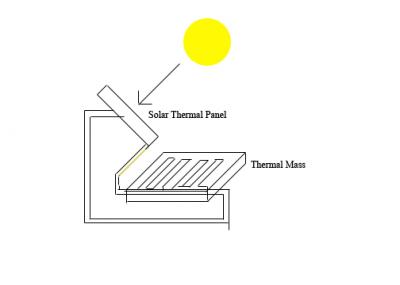 Do you have a question you would like to Ask The Sietch? Contact us or post your question in the Forums, and we will do our best to answer it. Got this one from the forum
Do you have a question you would like to Ask The Sietch? Contact us or post your question in the Forums, and we will do our best to answer it. Got this one from the forum
Got this one from the contact form a couple of days ago.
Kim has sent me this interesting question.
I am trying to find a simply explained (I’m inexperienced) & inexpensive way to build a solar heated small animal shelter. Would you have any suggestions? I am wondering if I could somehow adapt your plans (#2) for a solar thermal panel to provide a source of warmth and / or way to keep drinking water from freezing. I am hoping you can give me some guidance about whether this is logical, technically feasible….safe, etc. Your thoughts on what might work would be greatly appreciated.
Thank you.
Hi Kim. Yes you can safely and simply heat a small space (dog kennel, rabbit hutch, chicken coop, goat pen, etc) and/or keep water from freezing with solar power. There are basically two ways to do this, passively and actively.
If the animal you are trying to keep warm is a relatively hearty (aka its not some sort of rare tropical lizard that never experiences cold weather in its native habitat), like a dog or a goat or even a chicken and you can add a lot of heat to an enclosure with some passive methods.
First off you will want to think about changing seasons, in the summer time you are not going to want your animals as warm as the winter, and most animals have natural ways to stay warm, so you don’t want to make their homes so hot that they overheat (which can happen with animals with fur, even in the depths of winter). I would suggest that a good layer of insulation, and a shelter that keeps the animals out of the wind can go a long way towards keeping animals warm. A good sized dog, with a well insulated dog house will stay nice and toasty on even the coldest nights.
If you need a little more heat, you could try and build a passive solar enclosure. This would basically be a small greenhouse like structure that is attached to the insulated structure. See the image below.
The idea is that during the day the sun shines in (the heat is trapped by the glass) and heats up a thermal mass (bricks or a cement floor), then during the night you place an insulated cover over the glass (a big sheet of insulated foam, or insulation) and the animal can sit on the nice warm floor all night.
During the summer you might want to leave the insulated cover on all the time to keep the sun from heating up the inside. Chickens that get too warm can easily die.
You can enact this sort of insulation/passive solar way in a million ways. But the basic idea is to insulate, and heat a thermal mass (something that soaks up the heat during the day to release it at night).
If you need a little more “kick” you can try some active solar methods.
If you really need to heat something I would go and buy yourself a solar thermal panel. You can find dealers all over, and you can get one or two panels for less than 1000 dollars (most likely much less). You point the panel at the sun, and pump water through it, this water gets very warm, then you run this warm water through a thermal mass. See picture below.
Your solar panel collects heat from the sun, it is in essence a tiny greenhouse that concentrates and traps the infrared radiation (heat) from the sun. A series of small tubes in the panel allow you to pump water (or a glycol mix to prevent freezing in the winter) and transfer this trapped heat someplace else. In this case we would pour a small concrete slab with a network of tubes placed into it. The warm water flows through the system all day, and the concrete slab absorbs the heat. At night when the sun goes down the pump turns off and the warm concrete radiates the heat all night long. Combined with a very well insulated enclosure, and the animals own adaptations (fur, feathers, etc) you keep your critters warm.
You could also use a system like to keep water from freezing. Instead of running the network of tubes into concrete you would use a small copper coil of pipes and place it into the bottom of the water tank, in this way the water itself acts as your thermal mass. You would be heating up the water all day, and at night it would be warm enough not to freeze. During the summer you would detach this system because the water would get really warm.
So to answer your question, yes you can do this with solar. Yes it is safe, and yes it is feasible, even easy. You will still need to monitor your animals to make sure they are ok on really cold nights, but you would have done that any way. If you contact a renewable energy contractor in your area (especially one that has experience with solar thermal) they could help you whip up a system like this pretty easily.
I hope this helps, if you have any follow up questions feel free to contact me or leave a comment.


Hi, I have a related question. I’ve seen a homemade heated dog kennel made in a similar way to the coils in the concrete slab floors of houses. It was simply plugged into the mains. My question is, could I do a similar thing through a small solar panel connected to a battery? If so, what size panel would I need for a dog kennel, and what size battery? Jane
A solar panel connected to a battery would give you electricity, put not enough to run a heater. You would need a solar thermal panel (which create hot water) connected to a water tank instead.
hey I really need help with passive solar buildings and can you please leave me with some more information before Thursday December 10 2015. Your information was very helpful in the top comment so I really know that you can help me. How do these passive solar buildings keep a dog warm in the winter and cool in the summer? What glass to you build it with? And how does using this method maintain the temperature of the inside of the doghouse? Please I’m in need of great and I hope that you can reply. Thank You.